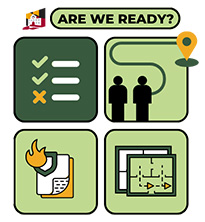Practice Makes Progress
The Importance of Drills and Exercises in Special Needs School Environments
In a recent post, we discussed a new, free, resource, Especially Safe: An Inclusive Approach to Safety Preparedness in Educational Settings. Especially Safe was presented to our school safety community by Michele Gay, Founder & Executive Director of Safe and Sound Schools® and Lee-Nadine Oppenheim, Director of Finance and Operations at Ivymount School. Both presenters have extensive knowledge of safety procedures, and how they relate to disabilities, accessibility, and functional needs of students and schools.
Our presenters discussed the importance of safety planning and drills, particularly for our special needs constituents. “Create a plan, share the plan with all of the stakeholders, update the plan, and keep everyone updated,” Ms. Gay said.
They explained how, although drills are an important big part of creating a safe school environment, prior planning is essential before drills. First, they said to realize it takes a team to create effective safety plans for students, teachers, and the community. It is important to identify people who may need additional assistance in an emergency and build the safety team around them.
This may include creating an Individual Safety Plan (ISP). Unlike an IEP, this is not a legal document, but it should be nimble and comprehensive. Ultimately, it can be used in conjunction with a student’s IEP and should be reviewed as often as possible.
Ms. Gay says to “Ask your safety team, what training, equipment, or accommodations will you need for helping this particular student-and don’t forget the maintenance around it.” She says taking a deep dive into planning is crucial. For example, are you including usage of medical devices, and people with asthma, diabetes, seizures, physical impairments, crutches, or wheelchairs in your plans? Have you planned for the possibility of a lengthy stay at an off-site evacuation location?
These subject matter experts suggest leveraging existing staff meetings and scheduled IEP meetings to discuss the safety plans for each student and their unique situation. This not only assists administratively, it helps have a cohesive and updatable safety plan for individual student needs.
Then, it is important to plan for every circumstance you may have. Ms. Gay says, “teach the training” to your staff and keep these plans updated frequently. She says updating the safety plans and keeping everyone aware of modifications is the hardest part of school safety planning, and where many schools fall short.
Part of planning for special needs members of our communities may involve bringing in emergency responders to your school. Introduce police, fire, emergency medical services, and emergency managers during safety drills. This helps orient students, builds confidence, and reduces anxiety during events.
After you have identified, planned and prepared for modifications, take a hard look at your physical building. Identify the physical areas of the building where bottlenecks, mobility challenges, and problem areas for your students may exist.
Drills can be overwhelming for staff and students, but the point is to prepare for emergencies. Drills enforce the skills of exiting a building when it is unsafe, and to know where to hide or seek shelter inside the building. Safety drills, of any kind, build muscle memory, automatic responses, and alleviate anxiety for students when there is a dangerous situation.
Our speakers stressed the importance of tabletop exercises; for schools to take ten minutes out of their week for planning, execution, and evaluation of their emergency preparedness.
Drills are for preparing for what-if situations, and we don’t always know the answers for a particular situation. It is OK for all staff to ask for assistance and send questions up through the safety team to address particular safety concerns for your unique building. That is what drills are for. Two-way communication after drills is critical in finding where problems are, and reinforcing what your school did right during the drill.
Not only will schools be teaching the training, but Ms. Gay says the safety drills students learn today are skills they may utilize later, “Teaching safety skills for life.”

Drills and Exercises-Are We Ready?
MCSS Introduces Tabletop Exercises
An important part of preparing for emergencies is validating the effectiveness of emergency plans.
Schools are required to conduct emergency drills throughout the school year. However, it is often better to talk it through-before you walk it through.
Tabletops are one type of discussion-based exercise. They are an important tool in preparing for emergencies. Tabletops allow team members to discuss their roles and responses before an emergency. Tabletops do not need to be all-day discussions. Rather, focused tabletops can often be completed in a few minutes and help reinforce participants’ understanding of emergency plans.
You can begin your tabletop exercises now by following this link or use the QR code.
LEGISLATIVE UPDATE: Since 2018, public schools are required to have emergency plans that “accommodate, safeguard, and evacuate students, staff, and visitors with disabilities on public school grounds.” Md. Code Ann., Educ. Art. § 7-435.
In brief: Section 7-435 of the Education Article, Annotated Code of Maryland requires that public schools’ emergency plans comply with the Maryland State Department of Education (MSDE) Emergency Planning Guidelines. These guidelines, most recently updated in 2019, require public schools to have a “comprehensive emergency plan [to] address prevention, protection, mitigation, response, and recovery and [to] provide guidance to accommodate, safeguard, and evacuate all students, staff, and visitors, including individuals with disabilities.” MSDE Maryland Emergency Planning Guidelines for Local School Systems and Schools (Dec. 2019)
